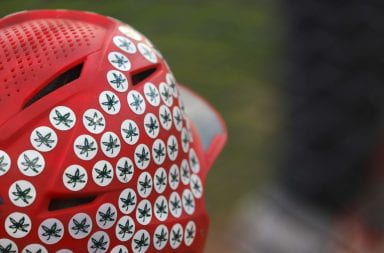
Osseointegration, a procedure that offers better mobility for amputees, was developed in Europe and had not been performed at the James Cancer Center until December. Credit: Jack Westerheide | Lantern File Photo
After years of blistering, discomfort and even breaking his prosthetic leg 4 miles into a mud race, 31-year-old Broc Potts needed a solution.
In December, Potts said he received the final step of an osseointegration procedure — developed in Europe 30 years ago to offer better mobility for amputees — at The James Cancer Hospital and Solove Research Institute. The James is the first cancer research center in central Ohio to use the procedure, Joel Mayerson, professor of orthopaedic surgery and medical director of the sarcoma program at the cancer hospital, said.
Mayerson, who performed Potts’ surgery, said his team at The James developed a way to put a metal rod inside the patient’s bone and change the way their soft tissues are arranged. This allows the skin to heal down to the bone, preventing infection and discomfort from calluses formed when using a prosthetic.
Mayerson said after a two- to three-month healing process following the initial procedure, the patient is brought in for a second procedure done by the plastic surgery team. After that procedure, it takes about two months for the wound to heal and for the patient to strengthen the muscles in the area.
Mayerson said the rehabilitation process happens over three to four months, where the patient gradually increases the amount of weight and pressure put on the bone through physical therapy. Once the bone and muscles are strong enough, they can get fitted for a prosthesis and begin gait training — training to learn how to walk properly — with a physical therapist.
Potts was initially diagnosed with osteosarcoma — a type of bone cancer — in 2001 after doctors thought a growth in his leg was a noncancerous cyst.
Following his diagnosis, Potts said his leg eventually had to be amputated, asit became “too far gone” after repeated attempts to save it with a metal rod and a dangerously low white blood cell count due to chemotherapy.
Potts said his first prosthetic leg came with challenges. He was initially fitted with a hydraulic prosthetic attached by suction. He said he would put on a rubber liner that allowed the prosthetic to attach without sliding off, but the liner caused blisters and discomfort.
“In summertime, you’re sweating pretty much all the time and you’re causing your leg to get all these blisters from going back and forth all the time,” Potts said. “I worked at a factory job, and I’d get home every single day and have blisters all over my leg.”
Potts said most amputees deal with this problem by waiting until a callus forms where the prosthetic is worn. But the discomfort was affecting Potts’ everyday life to the point where he could no longer work, so he said he reached out to Mayerson for help.
“I knew I needed something that would help me if I wanted to continue working. I needed something other than being in pain every single day,” Potts said. “I needed a new life.”
Mayerson said osseointegration is new to the U.S., and his team spent time perfecting the right technique to get approval for the procedure from the Food and Drug Administration. He said many cancer centers in the U.S. are starting to perform the procedure, following its FDA approval.
In December, Potts said he went through his osseointegration procedure — the first ever done at The James. Potts said as someone who has never been first for anything, he is happy to have gone through it.
“I have another shot at being something,” Potts said. “I have another shot at trying to walk without those blisters getting in my way.”
While osseointegration changed Potts’ life, he said adjusting to a new prosthetic has its challenges. He said learning to correct his gait and strengthening his hip muscles have been his biggest challenges, comparing his early stages of learning to walk as looking “like Bambi.”
Potts said he is still healing but is grateful for the opportunity to receive the procedure. He said he has already made use of his new prosthetic, picking up new hobbies such as wood carving and whittling.
“I feel [osseointegration] is the right way; it’s the positive side of things. It’s another shot, another opportunity,” Potts said. “It’s going to be painful and there’s going to be some sacrifices you’ll have to make, but if you really want comfortability, this is the way to go.”


